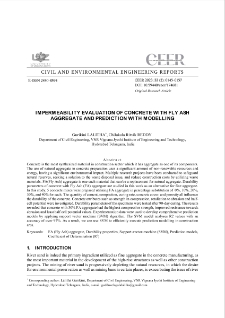Digital Library of Zielona Góra contains 9 285 digital objects
Object
Title: Impermeability evaluation of concrete with fly ash aggregate and prediction with modelling
Contributor:
Group publication title:
Abstract:
Concrete is the most synthesized material in construction sector which it has aggregate as one of its components. The use of natural aggregate in concrete preparation uses a significant amount of non-renewable resources and energy, having a significant environmental impact. Multiple research projects have been conducted to safeguard natural reserves, seeking a solution to the waste disposal issue, and reduce construction costs by utilizing waste materials. FA(Fly Ash) aggregate is one such material that can be a replacement for natural aggregate. ; Durability parameters of concrete with Fly Ash (FA) aggregate are studied in this work as an alternative for fine aggregate. In this study, 5 concrete mixes were prepared utilizing FA aggregate in percentage substitution of 0%, 10%, 20%, 30%, and 40% for each. The quantity of cement, compaction, curing rate, concrete cover, and porosity all influence the durability of the concrete. Concrete attributes such as strength in compression, retaliation to abrasion and half-cell potential were investigated. ; Durability parameters of the specimens were tested after 90-day curing. The results revealed that concrete with 30% FA aggregate had the highest compressive strength, improved resistance towards abrasion and least half cell potential values. Experimentation data were used to develop comprehensive prediction models by applying support vector machine (SVM) algorithm. The SVM model analyses R2 values with an accuracy of over 97%. As a result, we can use SVM to efficiently execute prediction modelling in construction area.
Description:
tytuł dodatkowy: Prace z Inżynierii Lądowej i Środowiska
Publisher:
Zielona Góra: Oficyna Wydawnicza Uniwersytetu Zielonogórskiego
Format:
Resource Identifier:
DOI:
Pages:
Source:
Civil and Environmental Engineering Reports (CEER), no 33, vol. 2
Language:
License CC BY-NC-ND 3.0:
Rights:
Biblioteka Uniwersytetu Zielonogórskiego
Object collections:
- Repository > Faculties > Construction department, Architecture and Environmental Engineering
- Repository > Types of work > Articles
- Repository > Scientific journals and UZ publishing series > Civil and Environmental Engineering Reports (CEER) > Civil and Environmental Engineering Reports (CEER) (2023)
Last modified:
Feb 2, 2024
In our library since:
Feb 2, 2024
Number of object content hits:
176
All available object's versions:
https://zbc.uz.zgora.pl/repozytorium/publication/86975
Show description in RDF format:
Show description in OAI-PMH format:
| Edition name | Date |
|---|---|
| Impermeability evaluation of concrete with fly ash aggregate and prediction with modelling | Feb 2, 2024 |
Objects Similar
Abdelouahed, Assia Hebhoub, Houria Kherraf, Leila Belachia, Mouloud Kuczyński, Tadeusz - red.
Haq, Anam Wilk, Szymon Abelló, Alberto Gamper, Johann - ed. Wrembel, Robert - ed.

